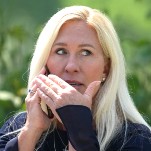Allure editor Linda Wells Explains Why Her Magazine is Different
LatestIn an extensive interview with the Business of Fashion, longtime Allure magazine editor Linda Wells reflects a bit on her success with the fashion and beauty publication she’s helmed since it was started in 1991, the one that most recently made headlines for putting actress Zoë Saldana’s weight on its cover.
Wells is very serious about making it clear that the choices her staff makes for their annual Best of Beauty Awards aren’t influenced by the magazine’s advertising department, though that doesn’t mean they haven’t had issues in the past with advertisers becoming displeased with negative reviews of products. Allure realized quickly, like Lucky, Vogue and others, that the way to make money is to integrate the fact that you are telling readers to buy things by essentially selling things to those same readers.
The most impressive thing about Wells is her ability to roll with the punches. As she explained to BOF, you never know what’s coming next in media:
-

-

-

-

-

-

-

-

-

-

-

-

-

-

-

-

-

-

-

-

-

-

-

-

-

-

-

-

-

-

-

-

-

-

-

-

-

-

-

-








































